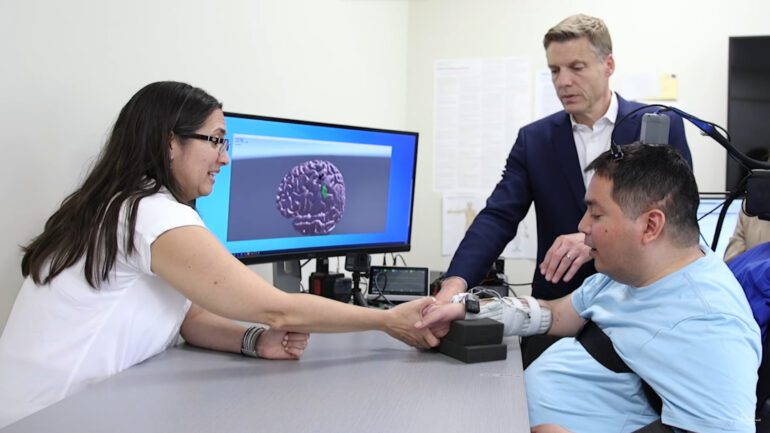TL;DR:
- Surgeons in the US successfully implanted AI-powered microchips into the brain of a quadriplegic man.
- AI reads, interprets, and translates his thoughts into action, enabling him to regain movement and sensation.
- The “double neural bypass” technique rewires pathways between the brain, body, and spinal cord, restoring functionality.
- AI-driven sensory feedback allows the patient to feel touch through tiny electrodes.
- The technology shows potential in retraining the spinal cord and strengthening connections for further recovery.
Main AI News:
In a groundbreaking achievement, medical pioneers in the United States have successfully restored touch and movement to a quadriplegic man by employing state-of-the-art AI brain implants. Keith Thomas, 45, who had suffered from paralysis due to a neck injury, is now regaining control of his limbs and experiencing sensations thanks to the revolutionary application of AI technology.
The revolutionary procedure involved the implantation of microchips directly into Thomas’ brain. These microchips served as a conduit for Artificial Intelligence, which read, interpreted, and translated his thoughts into actionable commands. The surgical feat was performed by a team of skilled medical professionals at the Feinstein Institutes for Medical Research in New York after meticulous brain mapping using MRIs.
Dr. Ashesh Mehta, the lead surgeon, described the wiring in Thomas’ brain as “broken.” To restore functionality, the surgical team embarked on a “double neural bypass” – a ground-breaking approach that involved rewiring pathways responsible for transmitting electrical signals between the brain, body, and spinal cord. With the assistance of AI, Keith’s thoughts were decoded and translated into physical movements by stimulating his hand, allowing him to regain control over it.
Notably, the bypass also worked in the opposite direction, enabling Thomas to experience touch through tiny electrodes instead of relying on neurons responsible for tactile sensations. The sensory data from his fingertips and palm were fed back to the brain implant through a computer, bypassing the damaged spinal cord. This ingenious technique effectively “fooled” the nervous system into restoring touch and movement, culminating in a truly remarkable transformation for the quadriplegic patient.
The developer of this pioneering technology, Chad Bouton, who serves as the principal investigator of the clinical trial and a professor at the Institute of Bioelectronic Medicine at the Feinstein Institutes, expressed profound emotions at witnessing the success of the procedure. When Keith held his sister’s hand and felt her touch after three years, it was an emotional moment for everyone involved, with tears of joy filling the laboratory.
Thomas’ progress has been nothing short of astounding. The surgical team anticipates that his brain, body, and spinal cord will undergo a relearning process, developing new pathways at the injury site thanks to the double neural bypass. Bouton likens the electronic bridge to “training wheels” for the spinal cord, helping it retrain and strengthen connections, gradually enabling Thomas to move and feel independently. The possibilities are boundless, with the potential to awaken dormant circuits and reverse years of damage.
Conclusion:
The successful restoration of mobility and sensation in a quadriplegic patient through AI brain implants marks a significant breakthrough in medical science. This groundbreaking technology has the potential to transform the paralysis treatment market. As research and development progress, we can expect to witness the emergence of more advanced AI-driven solutions, opening up new opportunities for patients worldwide. The market for AI-powered medical interventions is likely to experience exponential growth as this transformative technology paves the way for enhanced patient care and improved quality of life. Medical institutions and businesses involved in developing AI-driven medical devices stand to gain a competitive advantage, while patients eagerly await the potential for life-changing outcomes. As more success stories emerge, investor interest and funding in the AI medical sector are poised to surge, fostering a thriving ecosystem of innovation and possibilities.

